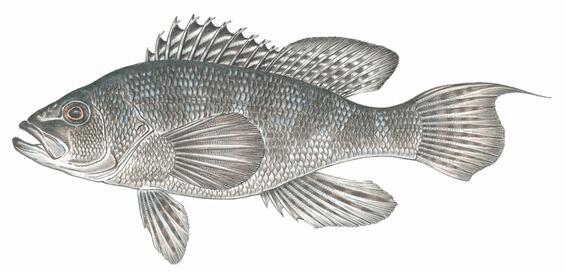Appearance
Black sea bass are stout-bodied with a long dorsal fin and large pectoral and pelvic fins. The dorsal fin has a spiny forward section and the soft rayed rear section, and is marked with a series of white spots and bands. The tail is rounded and sometimes has a long streamer at the top edge. As the name implies, their body coloration is blackish to grayish, but the center of the scales is white. During the spawning season, however, dominant males turn bright blue colors and have a large hump on their heads. Juveniles are brown in color and have a dark lateral stripe running down the body. Black sea bass can reach up to 25” in length and over 8 pounds in weight; although the majority of fish caught weigh less than 4 pounds.
Where they live
The black sea bass we find in Massachusetts formerly ranged from Cape Cod south to North Carolina; however, in the last decade or so, the Gulf of Maine has also become suitable habitat due to warming sea temperatures. They are a migratory fish, wintering in deep water off the coast of the mid-Atlantic states and traveling northward and inshore in the spring, generally arriving in large schools to Massachusetts waters sometime in May. Adult sea bass then take up residence over rocky bottoms or anywhere some structure can be found in depths of less than 150 feet. They are abundant in Massachusetts waters until October, with the largest concentrations found in Buzzards Bay and Nantucket and Vineyard Sounds. Juvenile and young-of-the-year sea bass tend to prefer estuaries, where they feed and avoid predators.
Life history
Black sea bass are protogynous hermaphrodites, meaning most fish start life as females and change into males (generally once they reach 9–13”). This change takes place over the fall and winter after spawning has ended, and is thought to be based on visual rather than chemical cues. Black sea bass are fast growing, reaching sexual maturing between 2–5 years (or 8–14” generally). Dominant males attract a group of females to mate, often referred to as a harem, and aggressively defend their territory. So-called subordinate males continue to look like females and await their turn to assert dominance. Spawning in Massachusetts occurs in late spring and early summer in relatively shallow water. Large females are capable of producing up to half a million eggs. Sea bass eggs float in the water column for only a few days before hatching into larvae that then settle in nearshore waters. After settling, the young juveniles migrate to estuaries where they grow and develop throughout the summer and early fall. Black sea bass are aggressive feeders, preying on a variety of small fishes as well as crustaceans and squid, which they eat whole. They can live up to 10–12 years.
Management
Black sea bass are highly sought after by both commercial and recreational fishermen. They are managed by the Atlantic States Marine Fisheries Commission and the Mid-Atlantic Fishery Management Council. The management plan divides the total annual quota between the recreational fishery (51%) and the commercial fishery (49%). Recreational regulations, including an open season, bag limit, and minimum size, vary by state and are adjusted annually to achieve the harvest limit. The coastwide commercial quota is divided into annual state-by-state quotas based on historical harvests (MA=13%), with specific management measures set by each state. In Massachusetts, the commercial fishery is limited entry and commercial fishermen are regulated by an open season and open fishing days, a daily possession limit, and a minimum size.
Additional Resources
Stock status
The most recent stock assessment of black sea bass was conducted in 2016. The spawning stock biomass (abundance of mature males and females) was estimated to be roughly 2.3 times the target spawning biomass level in 2015. This led to a much-needed coastwide quota increase in 2017. Both recreational and commercial fisheries are achieving their limits which has provided for largely status quo regulations since. An update to the stock assessment is due in late 2019, which is expected to form the basis of catch limits for the next few years.
Angling tips
The best fishing for black sea bass starts in May and extends throughout the summer when they are closest to shore. Any underwater structure – wrecks, jetties, piers, rock piles – will attract these fish. They can be found near shore in depths of up to 120 feet in the summer, with larger males at the deeper end of that range.
Bait fishing with crab, fish, or squid is generally the most productive tactic. Occasionally, black sea bass will strike at plugs, jigs, or lures. Although these fish have large mouths, use a smaller hook with a small sinker tied below it. The most commonly caught fish weigh between 0.5 and 2 pounds. Be careful when handling these fish because of their very sharp dorsal fin spines and opercula (gill covers).
Additional Resources
Seafood tips
Black sea bass is a mild flavored fish that is tender but firm. Raw meat is pale and translucent, turning bright white when cooked. It’s highly versatile, both in manner of cooking and the flavors it can accompany.
